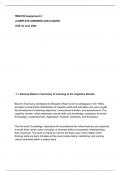TMN3706 Assignment 2
(COMPLETE ANSWERS) 2024 (530293)
DUE 24 June 2024
1.1. Discuss Bloom’s Taxonomy of Learning in the Cognitive Domain
Bloom's Taxonomy, developed by Benjamin Bloom and his colleagues in the 1950s,
provides a hierarchical classification of cognitive skills that educators can use to guide
the development of learning objectives, instructional activities, and assessments. The
cognitive domain, which addresses mental skills and knowledge, comprises six levels:
Knowledge, Comprehension, Application, Analysis, Synthesis, and Evaluation.
The first level, Knowledge, represents the foundational tier where learners are expected
to recall facts, terms, basic concepts, or answers without necessarily understanding
their meanings. This level is critical as it forms the basis upon which higher-order
thinking skills are built. Activities at this level include listing, identifying, and naming
various elements within a subject area.
, Comprehension is the second level, where learners demonstrate understanding by
interpreting the information. They explain, summarize, or paraphrase the learned
material, showing that they grasp the essential meaning behind the facts. This level is
crucial for ensuring that learners can articulate what they have learned in their own
words, thus reinforcing their understanding.
At the Application level, students use information, methods, concepts, and theories in
new situations. This involves solving problems that may not be immediately familiar,
thereby testing the learner’s ability to apply what they have learned in a practical
context. Example activities include implementing a procedure, carrying out experiments,
or using formulas in novel scenarios.
The fourth level, Analysis, requires learners to break down information into its
component parts to understand its structure and relationship. This critical thinking
process involves examining, contrasting, and categorizing information. Analytical skills
are essential for dissecting complex concepts and understanding how they interrelate,
which is vital for deeper learning.
Synthesis is the fifth level, involving the combination of elements to form a new whole.
At this stage, learners generate ideas, design plans, and create original work by
integrating diverse pieces of information. This creative process requires learners to think
beyond existing boundaries and produce new, coherent structures or solutions.
The highest level in Bloom's Taxonomy is Evaluation, where learners make judgments
based on criteria and standards. This involves assessing, judging, and critiquing ideas
and outcomes. Evaluation is essential for developing discernment and the ability to
make informed decisions. Example activities include evaluating theories, critiquing
arguments, and making decisions based on evidence.
In summary, Bloom's Taxonomy in the cognitive domain provides a structured approach
to developing higher-order thinking skills. It guides educators in designing lessons that
progress from simple recall of facts to complex evaluation and creation, thus fostering
deeper learning and critical thinking skills in students.




